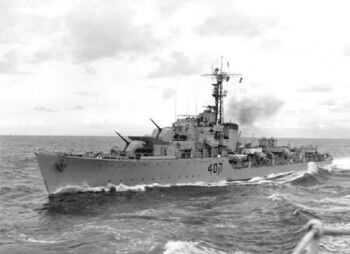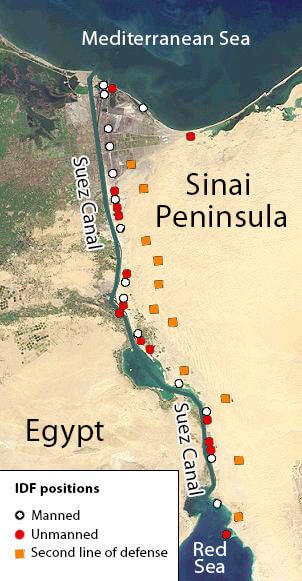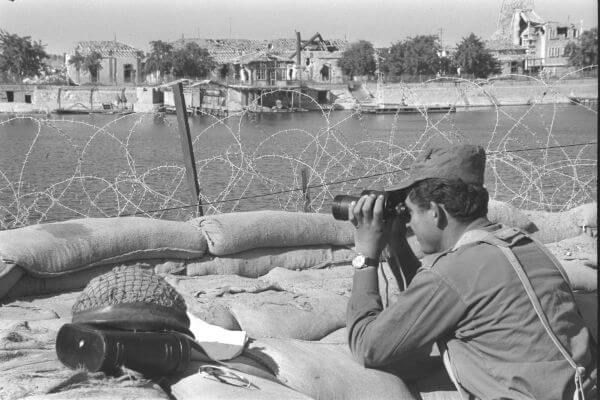Israel is the only country in the world that lives in a status called “the war between the wars.” Since it is surrounded by enemies who seek its destruction, even when not in official wartime, it is constantly dealing with small scale attacks from those enemies. The greatest example of this status is the three-year period from 1967 to 1970, a period which is now referred to as the “War of Attrition.”
One would have thought that Israel’s resounding victory over all the neighboring Arab countries in the June 1967 Six Day War would have given the Jewish state a few years of peace and quiet.
Related reading: The Six-Day War: A Concise Timeline
But this wasn’t the case.
Egyptian President Gamal Abdel Nasser was determined to do whatever possible to win back the Sinai Peninsula which Israel captured during the war that ended on June 9, 1967. While the Six Day War was over, it wasn’t long until the War of Attrition began.
Join the fight for Israel’s fair coverage in the news
The War of Attrition’s Beginnings
As early as July 1, Egyptian commandos moved to within 10 miles of the Israeli position on the eastern side of the Suez Canal. Israel, working under a plan to prevent Egyptian forces gathering in the area, attacked the commandos and lost one soldier with 13 wounded. The next day, the Israeli air force bombed the Egyptian artillery that was providing cover for its commandos. That led to an Egyptian air force strike against Israeli forces in the Sinai and, for all intents and purposes, the June 9 ceasefire was no longer relevant. Skirmishes between the two sides continued throughout July with numerous Egyptian fighter jets shot down by Israel and Israel sinking two Egyptian torpedo boats.

There was relative quiet during August, September and most of October but then on October 21, 1967, the Egyptian Navy sunk the Eilat, an Israeli naval destroyer, in international waters off the coast of Port Said, killing 47 Israeli sailors. Israel retaliated with extensive bombing of Egyptian oil refineries and depots in the region, resulting in significant artillery battles between the two sides, with the Egyptians suffering civilian casualties.
The back and forth continued in 1968 with Egyptian artillery attacks against Israeli positions leading to Israeli reprisal attacks. Israeli leaders believed that they had to take action to bring an end to the constant Egyptian attacks which were taking a toll on Israel. On October 30, 1968, IDF commandos destroyed an Egyptian electric transformer station along with two dams and a bridge by the Nile River. The attack led to a large-scale blackout in Egypt and the damage led to months of quiet. This break enabled Israel to reinforce itself along the eastern bank of the Canal via the construction of the “Bar Lev line.”

Egypt re-engaged Israel on March 8, 1969, with heavy artillery fire and airstrikes against the IDF, causing significant Israeli casualties. The IDF responded forcefully, sending troops deep into Egypt to strike military targets. The next day, Israel killed the Egyptian Chief of Staff, General Abdul Munim Riad while he was visiting Egyptian forces along the Canal. From hereon the fighting between the two sides escalated for months with heavy casualties on both sides.
Israel once again decided that it had to take serious military action to try to stop the constant Egyptian attacks. On July 19, 1969, Israel launched this operation with a commando attack on the Egyptian military position at Green Island, killing 80 Egyptian soldiers, followed by the Israeli air force attacking Egyptian forces at the northern part of the Suez Canal, killing 300 Egyptian soldiers, and seriously damaging the Egyptian positions. This was followed up by approximately 1,000 Israeli air force missions in August, destroying Egyptian missile launching sites and over 20 Egyptian fighter jets.
The Superpowers Get Involved
Beginning in October 1969, the United States and the Soviet Union began to engage the sides in diplomatic talks to end the fighting. But when these attempts failed, the Soviet Union sent significant arms and soldiers to help the Egyptians, ultimately leading to dogfights between Israeli and Egyptian pilots during which the Israeli air force shot down numerous Russian planes.
Israeli retaliation for Egyptian attacks continued until April 8, 1970, when Israel erroneously attacked a school, believing it to be an Egyptian military installation. The attack killed 46 Egyptian children and injured over 59. Israel decided to cease its counter attacks at that point. This change in policy allowed the Egyptian and Soviet forces to get closer to the Canal than Israel had wanted. The combination of the damage suffered by the Egyptian army alongside its military gains, along with the casualties it caused on the Israeli side and its ability to bring its forces closer to the canal, allowed for a cease fire to be reached on August 7, 1970, with no change in the borders from the 1967 war and with neither side committing to peace negotiations.

Sadat Lays Groundwork for Yom Kippur War
Egyptian President Nasser died of a heart attack on September 28, 1970 and his successor, Anwar Sadat, adhered to the cease fire, focusing on rebuilding and preparing the Egyptian army for a full-scale attack against Israel which would take place in October 1973’s Yom Kippur War.
There are conflicting reports regarding how many Israelis were killed between June 1967 and August 1970, during this War of Attrition. The number ranges from 600 to 1,400 with thousands injured. Israel lost more than 20 aircraft as well as its destroyer, the Eilat. On the Egyptian side, the estimates range from 2,882 killed and 6,285 wounded to as many as 10,000 killed. Egypt also lost over 100 aircraft and several ships.
This three-year War of Attrition set the stage for the Yom Kippur War three years later. It led Israel into a state of further complacency, convinced that it could fight off any attacks that came from its neighboring enemies. The damage which Egypt was able to inflict on Israel during these three years empowered Egypt and Israel’s other neighbors to feel confident that they could ultimately achieve their joint goal to destroy the Jewish state militarily.
Liked this article? Follow HonestReporting on Twitter, Facebook, Instagram and TikTok to see even more posts and videos debunking news bias and smears, as well as other content explaining what’s really going on in Israel and the region.
Images: INS Eilat via Wikimedia Commons;


